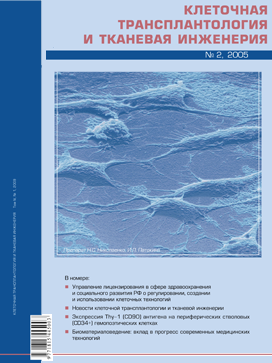Синтетические биоматериалы на основе полимеров органических кислот в тканевой инженерии
- Авторы: Волков А.В.
- Выпуск: № 2 (2005)
- Страницы: 43-45
- Раздел: Мини-обзоры
- Статья получена: 04.03.2023
- Статья одобрена: 04.03.2023
- Статья опубликована: 06.03.2023
- URL: https://genescells.ru/2313-1829/article/view/313382
- ID: 313382
Цитировать
Полный текст
Полный текст
Список литературы
- Agrawal C.M., Athanasiou K.A., Heckman J.D. Biodegradable PLA/PGA polymers for tissue engineering in orthopaedica. Material Science Forum 1997; 250: 115-28.
- Alcock H.R. Inorganic-organic polymers as route to biodegradable materials. Macromol. Symp. 1999; 144: 33-46.
- Andriano K.P., Tabata Y., Ikada Y., Heller J. In vitro and In vivo comparison of bulk and surface hydrolysis in absorbable polymer scaffolds for tissue engineering. J. Biomed. Mater. Res. 1999; 48: 602-12.
- Attawia M.A., Uhrich K.E., Botchwey E. et al. Cytotoxocity testing of poly(anhydride) for orthopaedic applications. J. Biomed. Mater. Res. 1995; 29: 1233-40.
- Behravesh E., Yasko A.W., Engle P.S., Mikos A.G. Synthetic biodegradable polymers for orthopaedic applications. Clin. Orthop. 1999; 367S: 118-85.
- Bostman O.M. Osteolytic changes accompanying degradation of absorbable fracture fixation implants. J. Bone Joint Surg. 1991; 73B: 679-82.
- Bostman O.M. Intense granulomatous inflammatory lesions associated with absorbale internal fixation devices made of polyglycolide in ankle fractures. Clin. Orthop. 1992; 278: 178-99.
- Bostman O., Paivaarinta U., Partio E. et al. Degradation and tissue replacement of an absorbable polyglycolide screw in the fixation of rabbit osteomies. J. Bone Joint Surg. 1992; 74A: 1021-31.
- Bostman O., Partio E., Hirvensalo E., Rokannen P. Foreign-body reactions to polyglycolide screws. Acta Orthop. Scand. 1992; 63: 173-6.
- Burg K.J.L., Porter S., Kellam J.F. Biomaterials development for bone tissue engineering. Biomaterials 2000; 21: 2347-59.
- Chu C.C. The in vitro degradation of poly(glycolic acid) sutures- effect of pH. J. Biomed. Mater. Res. 1981; 15: 795-804.
- Domb A.J. Poly(propylene glycol fumarate) compositions for biomedical applications. United States Patent 1989; 4888; 413: 1-31.
- Domb A.J., Langer R. Polyanhydrides I: Preparation of high molecular weight polyanhydrides. J. Polym. Sci., Part A, Polymer Chem. 1987; 25: 3373-86.
- Frazier D.D., Lathi V.K., Gerhart T.N., Hayes W.C. Ex vivo degradation of a poly(propylene glycol-fumarate) biodegradable particulate composite bone cement. J. Biomed. Mater. Res. 1997; 5; 35(3):383-9.
- Gogolewski S., Pennings A.J. An artificial skin based on biodegradable mixtures of polylactides and polyurethanes for full-thickness skin wound covering. Makromol. Chem. Rapid. Commun. 1983; 4: 675-80.
- Jen A.C., Peter S.J., Mikos A.G. Preparation and use of porous poly(a-hydroxyester scaffolds for bone tissue engineering. In: Tissue Engineering Methods and Protocols. Morhgan J.R, Yarmush M.L eds Humana Press, Totowa: 1999; 133-40.
- Kronenthal R.L. Biodegradable polymers in medicine and surgery. Polymer Sci. Technol. 1975; 8: 119-37.
- Laurencin C.T., El-Amin S.F., Ibim S.E. et al. A highly porous 3-dimentional polyphophazene polymer matrix for skeletal tissue regeneration. J. Biomed. Mater. Res. 1996; 30: 133-8.
- Peter S.J., Miller M.J., Yaszemski M.J., Mikos A.G. Poly(propylene fumarate). In: Handbook of Biodegradable Polymers. Domb A.J., Kost J., Wiseman D.M. eds. Harwood Academic Publishers, Amsterdam: 1997; 87-98.
- Skarja G.A., Woodhouse K.A. Synthesis and characterization of degradable polyurethane elastomers containing an amino acid-based chain extender. J. Biomater. Sci. Polym. Ed 1998; 9: 271-95.
- Temenoff J.S., Mikos A.G. Injectable biodegradable materials for orthopedic tissue engineering. Biomaterials 2000; 21: 2405-12.
- Thomson R.C., Wake M.C., Yaszemski, Mikos A.G. Biodegradable polymer scaffolds to regenerate organs. Adv. Polymer. Sci. 1995; 122: 245-74.
- Van Sliedregt A., van Blitterswijk C.A., Hesseling S.C. et al. The effect of the molecular weight of polylactic acid on in vivo biocompatibility. Adv. Biomaterials 1990; 9: 207-12.
- VanSliedregt A., Radder A.M., deGroot K., Van Blitterswijk C.A. In vitro biocompatibility testing of polylactides Part I: Proliferation of different cell types. J. Mater. Sci.: Mater. Med. 1992; 3: 365-70.
- William D.F., Mort E. Enzyme-accelerated hydrolysis of polyglycolic acid. J. Bioeng. 1977; 1: 231-8.
- Wong W.H., Mooney D.J. Synthesis and properties of biodegradable polymers used as synthetic matrices for tissue engineering. In: Synthetic Biodegradable Polymer Scaffolds. Atala A., Mooney D., eds. Burkhauser, Boston; 1997: 51-84.
- Yazemski M.J., Payne R.G., Hayes W.C. et al. Evolution of bone transplantation: molecular, cellular and tissue strategies to engineer human bone. Biomaterials 1996; 17: 175-85.
- Gunatillake P.A., Adhikari R. Biodegradable synthetic polymer for tissue engineering. European Cells and Materials 2003; 5: 1-16.
Дополнительные файлы
Доп. файлы
Действие
1.
JATS XML
2.
Рис. 1. Схема гидролиза PGLA. Продукты гидролиза не токсичны и участвуют в цикле Кребса с образованием углекислого газа и воды
Скачать (7KB)
Скачать (119KB)
Скачать (182KB)
Скачать (3KB)
6.
Рис. 5. Фибробластоподобные клетки, адгезировавшие в условиях культуры к гранулам капролактона (А) и к пористому капролактону (В). СЭМ
Скачать (163KB)















